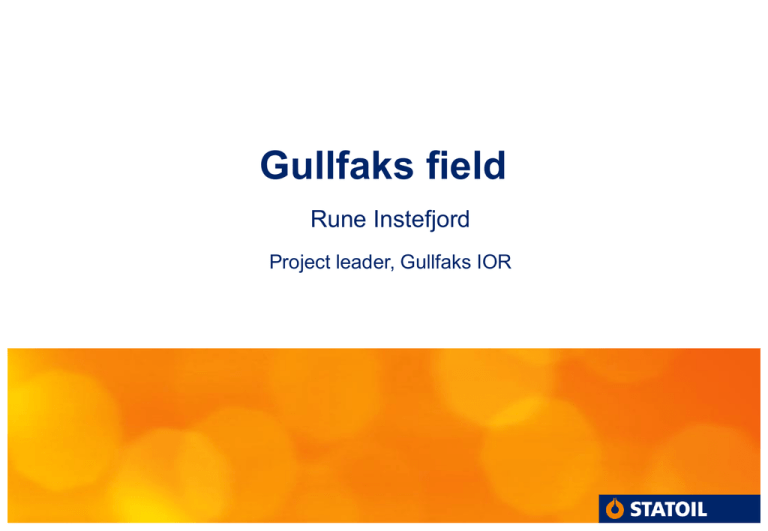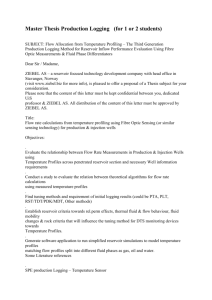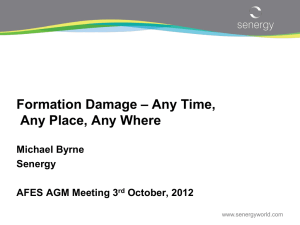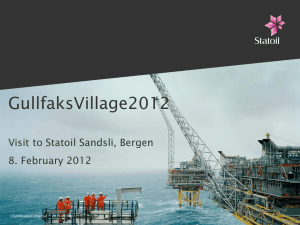Gullfaks field
advertisement

Gullfaks field Rune Instefjord Project leader, Gullfaks IOR Key data for GF main field • Location: northern North Sea • Discovered: 1978 • Gullfaks Gullfaks • • Start production: 1986 • Location: northern North Sea • Start Baseproduction: oil reserves: 1986 356 Mill. Sm3 • Discovered: 1978 • Base Produced to date: 327Mill. Mill.Sm Sm3 reserves: 356 Expected recovery: 61 %Mill. Sm3 • • Produced to date: 327 • – Recovery pr. 2006: 56% Expected recovery: 61 % • Initial pressure: 310-320 bar at 1850 m TVD MHN • Bubble point pressure: ~200-240 bar at 1850 m 3 500 TVD MHN Rate 1000 Sm3/month 3 000 2 500 • GOR: ~ 100 Sm³/Sm³ 2 000 • Viscosity: ~ 0.5 – 1 cp 1 500 1 000 • Dip angel in western part: 12-15 deg 500 0 1986 1988 1990 Basis Water 1992 1994 1996 1998 IOR Water 2000 2002 2004 Basis OIL 2006 2008 2010 IOR Oil 2012 2014 2016 2018 2020 Start prognosis Gullfaks Field -Structural setting and reservoir performance, Gullfaks Field • Complex fault system – – – Main fault system trending north-south: large faults (50 – 250 m throw) Secondary fault system east-west (10 – 100 m throw) Three structual areas C B C B A • A major challenge to realise the IOR potential, is a continuous improvement of the structural description by – – frequent seismic surveillances (conventional time lapse and Ocean Bottom Seismics) Use of advanced geological and reservoir simulation models Structural Depth Map, top Statfjord Fm. View from south. A Vertical scale 4x horisontal msl 5 km Post-Jurassic sediments Domino System Accommodation 1000 m Horst 2000 m Brent Gr. Statfj. Fm. Tordis breakaway fault 3000 m 4000 m Intra-Teist refl. 5000 m Low-angle detachment 6000 m Basement 7000 m 8000 m Structural interpretation Line 736 W CDP 400 600 800 E 1000 1200 1400 0000 0000 HORST COMPLEX 1000 1000 ACCOMODATION DOMINO SYSTEM 2000 2000 3000 3000 4000 Intra-Lomvi reflector 4000 5000 5000 Cretaceous/Tertiary sediments Base Cretaceous unconformity Brent Group Statfjord Fm. Reservoir Quality • Reservoirs: Brent, Cook, Statfjord & Lunde • Complex reservoir, very faulted • Porosity: 25-35 % • Permeability: – Tarbert, Etive, good Ness, good Statfjord and Cook- 3 >1D – Rannoch, poor Ness, poor Statfjord, Cook-2 and Lunde : 100 mD – 1 D • Moderate-to-High Reservoir Quality • Contrasting layers • Weak formations DRAINAGE STRATEGY (primary) • Aquifer support • Water injection • Reservoir pressure over bubble point • Injectors in the water zone • Producers high on structure Drainage strategy Secondary: Secondary: Secondary: Secondary: Secondary: Gas ••••• Gas injection, up-dip Gas Gas Gasinjection, injection, injection, injection,up-dip up-dip up-dip up-dip •••• WAG injection WAG WAG WAGinjection injection injection • WAG injection (continues) Why? Why? Why? Why? ••• Avoid Avoid Avoid production production reduction reduction when when gas gas export export is is at at its its production reduction when gas export • maximum Avoid production reduction when gas export is at itsis at its maximum maximum maximum •• Reduce Reduce storage storage costs costs and and CO CO22 tax tax •••• Reduce storage costs and CO tax Reduce storage costs and CO Produce Produce attic attic oil oil 2 tax2 •••• Produce atticoil oil Produce attic Reduce Reduce residual residual oil oil saturation saturation •••• Reach areas difficult to reach injection, ex. Reach Reach Reduce areas areas residual difficult difficult oil saturation to to reach reach with with with water waterwater injection, injection, ex. ex. Ness Ness by by LB LB injection injection Ness by LB injection • Reach areas difficult to reach with water injection, ex. Ness by LB injection Get Get uniform uniform drainage, drainage, decrease decrease sand sand production production Drain Drainuniform Get by-passed by-passed drainage, oil oil decrease sand production Get uniform drainage, decrease sand production Drain by-passed oil Drain Createby-passed gas lift, saveoil drilling costs Create gas lift, save drilling costs • Reservoir pressure under bubble point • Reservoir pressure under bubble point •• •• •• •• • Commingle pressure productionunder bubble point •• Reservoir Accelerate •• Create gasproduction lift, save drilling costs • Commingle production • Accelerate production •• Horizontal Horizontal wells wells • Horizontal wells Horizontal wells Gullfaks reserves estimates through time 700 700 600 530 540 564 540 560 600 STOOIP (3,6 billion bbl) 581582 587 582581582 538 522 510502 500 588585 579 574 Remaining oil 500 478 400 400 300 321 325 317319 309 332 342 2,2 billion bbls 352 355 BASE PROFILE 300 284 257 230 240 RESERVES 230 211210 200 200 PRODUCED 100 100 Historie Basis profil Reserver STOOIP 2020 2019 2018 2017 2016 2015 2014 2013 2012 2011 2010 2009 2008 2007 2006 2005 2004 2003 2002 2001 2000 1999 1998 1997 1996 1995 1994 1993 1992 1991 1990 1989 1988 1987 1986 1985 1984 1983 1982 0 1981 0 1980 Olje (MSm³) 452 Reserves Growth Gullfaks Sammenligning av prognoser for basis oljeproduksjon Gullfaks hovedfelt year Sm3 Mill.mill pr. år Sm 3per 35 In additon, tie-in of satellite fields has increased the oil and gas sales from the field (1994 Tordis, 1998 GF Satellites Phase 1, 2001 GF Satellites Phase 2. 30 25 20 Present prognosis for economical lifetime: Year 2018. Ambition: Year 2030 15 10 5 0 88 Rev PUD 93 Høst 94 Høst RSP 00 RSP 02 RSP 03 RSP 04 2016 2014 2012 2010 2008 2006 2004 2002 2000 1998 1996 1994 1992 1990 1988 1986 Produsert RSP 96 IOR at Gullfaks Main reasons for improved recovery • Continuous focus on reservoir description and monitoring • An increased no. of drainage points / wells and the use of superinjectors for water injection • Supplementary gas injection (WAG) in selected reservoir segments • Increased process capacities where necessary both for water (prod/inj), liquid, oil and gas • Reduced inlet separator pressure • Use of time-lapse (4D) seismic to map remaining hydrocarbons Ambitions in Long Range Plan • Produce 400 Mill. Sm³ oil in the field life time. Corresponding to around 70% recovery factor on the main field. • Cost reductions and an active IOR implementation is the most important instrument to reach the ambition. • Lengthening the field life time with several years. • Third parts processing. 35 30 25 20 15 10 5 Basis Basis+ØOU Ambisjon 2026 2022 2018 2014 2010 2006 2002 1998 1994 1990 0 1986 Millions Oljeproduksjon (Sm3/år) Gullfaks Main Field – oil rate prognosis Gullfaks ”IOR ambition” project • • Duration: 2006-2008. Main goal: mature the undefined IOR ambition volumes (and more?) to RC 5. – Identify specific measures and demonstrate that they may be economical feasible. Gullfaks Hovedfelt Basis profil Senfase trykkavlastning Cook Infill Cook Lavtrykk Cook Forbedret sweep i Cook ved økt vanninjeksjon Nye IOR-brønner i Brent Massiv vannsirkulering i Brent Statfjord IOR Massiv vannsirkulering Statfjord Krans/Kyrre IOR Lunde IOR CO2 prosjekt Ambisjonsprofil Lunde IOR 0,4<Sw<0,6 Sum all IOR Measures 0-3 7A 4A 7A 4A 4A 4A 7A 4A 7A 7A 6 7A 7F Sum Gullfaks Cook Cook Cook Cook Brent Brent Statfjord Statfjord Krans Lunde Brent Gullfaks Lunde All Mill Sm³ 356,7 1,0 0,2 1,1 0,2 10,6 7,0 0,2 1,3 0,5 2,1 17,4 1,7 43,3 Gullfaks Main Field. Improved oil recovery. Implemented: Implemented (continued): • Water injection from start • Multilateral wells • Upgrading of water injection capacities • Coiled Tubing drilling • Sand control (screens) in most wells • Through tubing drilling • ”Designer wells” (horisontal, 3D) • Rig assisted snubbing • Extended reach drilling (9 km drilled, 10 km well is beeing • Underbalanced drilling drilled) • Extensive exploration activity within drilling reach from • Expandable liners • 4D seismic platforms => new volumes • Hydraulic fracturing in low perm reservoirs Studied, but discarded: • WAG (Water alternating gas) injection • Surfactant injection (pilot) • ”Huff and puff” gas injection • Gel blocking (pilot) • Monobore completions • CO2 miscible injection • ”Intelligent wells”, remotely operated zone isolation valves Under evaluation: • MIOR (Microbiological IOR) Water circulation • Main mechanism for IOR at Gullfaks. 1,0 • Done a simulation study with extended 0,8 • Maximum use of platform capacity for all Krw - Referanse Krw - Sor = 0.2 Kro - Referanse Kro - Sor =0.2 0,7 Rel. Perm. water injection. 0,9 0,6 0,5 0,4 0,3 0,2 phases. 0,1 0,0 0 • Residual oil saturation down to 5% from 0,4 0,6 0,8 1 Water Saturation lab experiments. 0,10 0,09 0,08 • Drilling infill wells, both injectors and 0,07 Rel. Perm. producers. 0,2 0,06 0,05 0,04 0,03 0,02 0,01 0,00 0,6 0,65 0,7 0,75 0,8 0,85 Water Saturation 0,9 0,95 1 Water circulation, results • Most important mechanism is the creeping relative permeability and long tail production from each well. • One well has historically produced with oil rate < 100 Sm³ and wct > 0,9 for 7 years. • H2S is a problem, but nitrate injection seems to control it. • Water production may be an environmental challenge. Added use of today’s medicine gives the highest contribution to the future recovery. WCT vs cumulative oil, history and prediction Drilling history at Gullfaks • 3 platforms with 42, 42 and 52 slots. • Started with vertical wells (less than 60 deg) and 6 sub sea wells. • After 4-5 years drilled horizontal wells. • Water breakthrough gave sand problems: – Gravel packed wells, screen, – Fractured wells with proppants. • Last 5 years – Sidetracks. – Through Tubing Drilling. – Multilateral incl. DIACS in the well junction. Sand handling project Assumption: Kurve for MSR-testing Wells classified after probability for erosion. Allow higher sand production rate in the cases with low erosion risk. Monitoring erosion progress. Started at Gullfaks A in 2003 after a pilot at GFA on 3 wells in 2002. Installed at all 3 platforms in 2004. Both accelerate and increase oil recovery. Sand i sandfelle (gram/time) Most wells on Gullfaks has sand production. 100 90 80 70 60 50 40 30 20 10 0 0 •Cumulative gain for ASR in 2003: 216 000 Sm³ which gives a daily rate of around 590 Sm3/d 2 4 6 8 10 Tid (timer etter bunn opp på ny rate) 12 Seismic acquisition on Gullfaks Surface seismic 1985, 1996, 1999, 2003 Shadow area OBS acquired in 2001 OBS acquired In 2003 Based on 4D/4C seismic… Well B-41A successfully drilled late 2000 Well C-44A successfully drilled early 2001 After 1996 survey: Well C-26AT2 drilled in 2003 X Well C-15C drilled 2003 After 1999 survey: Potential new well location cancelled Well B-15AT4 successfully drilled 2003 After 2001 survey: Well B-4A successfully drilled in 1999 After 2003 survey: Well C-43 under drilling Well A-29A successfully drilled in 2003 Well A-21A successfully drilled early 2000 Well A-46T2 drilled mid-2000 Status 4D • Based on 4D seismic we have drilled more than 10 wells with success. • Top Brent (Tarbert), top Etive, top Cook and top Statfjord are the formations where 4D has been most valuable. • Ness, Rannoch and lower part of Statfjord is more difficult. • Have seen 4D effects in areas around injectors were the pressure is significance higher than initial pressure. • All wells have hit their target and most of them produced more than expected in the ‘Recommendation To Drill’. Flooding map Reservoir monitoring and management Simulation models Structural framework Sedimentology, detailed stratigraphy Reservoir description and initial volume Time-lapse seismic 1985 Top reservoir OWC OWC 1999 Top reservoir Production, injection rates, RST and PLT Well position, and perforation levels Flooding map Water flooded Partly water flooded Uncertain flooding Oil producer Gas flooded or originally in place Future producer WAG injector Oil filled Water injector Gas injector Alternative recovery methods • Surfactant pilot in the early 1990’s. Full field project stopped due to: – Chemical cost was too high relative too its efficiency. – Remaining oil saturation after water flooding was lower than expected. – Surfactant system efficiency was too little robust. • CO2 MWAG Study last years – Simulations done on Frontsim and Eclipse 300. – Potential of 10-20 Mill. Sm³ oil identified. – Too high cost totally and therefore a none economic project with to days framework condition. AMIOR • Alternative project to reduce residual oil at Gullfaks. • Add nitrate (doing already due to reduction of H2S), phosphate and oxygen to the injection water. • Reducing surface tension between oil and water and thereby mobilize oil. AMIOR • Pilot in well A-41B recommend. • Closed area with steady-state conditions. • Good reservoir understanding. • Good spacing between injector and producer. • A-36 has an established water cut growth. • A-41B is perforated in the oil zone. Prospects • A wide range of prospects in the licence. • Drill from the platforms where possible. • Use existing infrastructure to produce from the discoveries. • Commercial solutions for prospects across licence boundary. • Coordinate exploration and production drilling. • Combine targets where possible. Conclusions • Recovery of 400 mill. Sm³ (app. 70% recovery factor). • Lengthening the field life time. • Water circulation is the main IOR method. • Drilling of new and less expensive wells important. • Alternative recovery methods may be a substantial part of the future. • Exploration and third part processing contributes. • Close collaboration between the different technical disciplines is an important premise to reach the ambition. Requirements to moving volumes from resource category 7a and 6 to 5a Requirements to moving volumes from resource category 7a and 6 to 5a, cont… • • • Profitable measure Assumptions regarding this evaluation are given in Appendix B Likelihood of implementation equal to or greater than 30 %. A way of calculating the likelihood of implementation is given in Appendix C. • Prepare plan (studies, eventual technology qualification, manning, budget,) and timing for next phase (when is the right time to proceed). The level of detail of such a plan depends on the size of the project/measure. Documentation shall include; – Production effects (all HC phases) in the targeted reservoir(s) – Simple uncertainty estimation for production effects (low-medium-high) – Is the measure competing with other measures (yes/no – which ones) – Evaluate whether the measure has any consequence for process capacities[1] (yes/no – which ones) – Cost(Capex and OPEX) estimate for the measure (class A) – Economical evaluation – Plan and timing of next phase • • [1] If yes; will the measure displace other measures?





